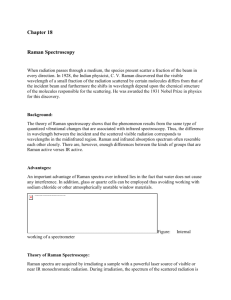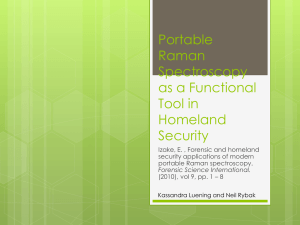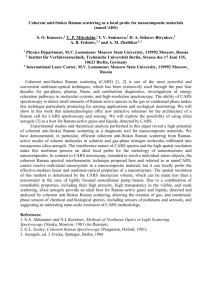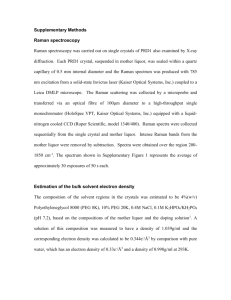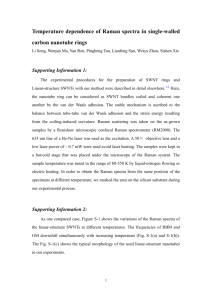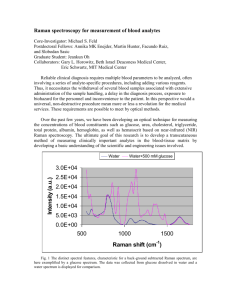PPT - Monterey Bay Aquarium Research Institute
advertisement
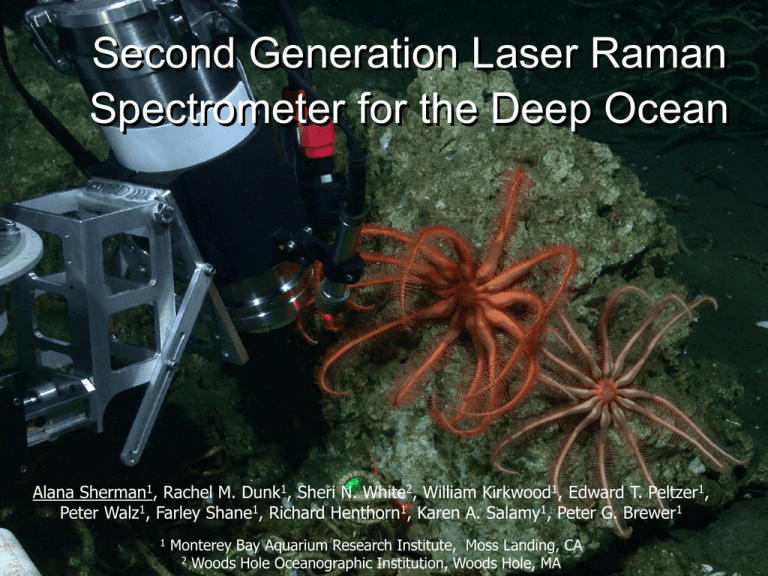
Second Generation Laser Raman Spectrometer for the Deep Ocean Alana Sherman1, Rachel M. Dunk1, Sheri N. White2, William Kirkwood1, Edward T. Peltzer1, Peter Walz1, Farley Shane1, Richard Henthorn1, Karen A. Salamy1, Peter G. Brewer1 1 Monterey Bay Aquarium Research Institute, Moss Landing, CA 2 Woods Hole Oceanographic Institution, Woods Hole, MA Raman Spectroscopy • Vibrational spectroscopy – Based on Raman scattering • The inelastic scattering of monochromatic radiation – The shift in energy of the scattered light is equal to the change in the vibrational energy of the molecule – The Raman spectrum serves as a fingerprint of a substance based on molecular composition and local environment Raman Spectroscopy in the Ocean • The technique provides the ability to make in situ geochemical measurements in the deep ocean. • Advantages of Raman Spectroscopy: – Can analyze solids, liquids and gases – Rapid analysis – Can perform in situ analysis targets with stability zones confined to the deep ocean – Generally non-destructive, and requires little or no sample preparation Raman Spectroscopy in the Ocean • A number of oceanic targets are Raman active: – Gases • CO2, CH4, N2, O2, H2S, etc. – Minerals • Sulfides, anhydrite, calcium carbonates, silicates, feldspars, magnetite, etc. – CO2 and CH4 hydrates DORISS 1 Deep Ocean Raman In Situ Spectrometer 40” 1 1 10” 2 3 3 2 15” 6” 20” 12” Operations ROV deployed instrument Spectrum Probe head Doriss2 Intensity (Counts) • The instrument housing is mounted in the rear drawer of the ROV • The probe head is carried in front of the ROV • Communications between Doriss and shipboard computer via Ethernet • Spectra of targets, video, and environmental data are transmitted back to the operator Raman Shift (cm-1) DORISS1 • Scientific Successes – First deep ocean Raman spectra – 3 years of successful deployments – Collected data from hydrothermal vents at Gorda Ridge, natural hydrates from Hydrate Ridge – Demonstrated worth of technique – 8 papers published • Technical Challenges – Prototype instrument not suitable for routine expeditionary use • Weight and size • Sensitivity • Reliability and robustness DORISS2 Laser CCD camera Power Supply Spectrometer (Kaiser Optical Systems NXRN model) Computer DORISS2 • Improvements: – U-shaped spectrometer simplifies housings – 90 lbs lighter than DORISS1 • Can be deployed on vehicles with limited payload – Increased sensitivity, due to new back illuminated CCD camera – More robust and reliable 12” diameter, 30” long DORISS2 Data CH4-H2S Fractionation CH4-H2S Fractionation Disappearance of the 2610 Δcm-1 H2S peak with time. In Situ Calibration • Would like a way to calibrate intensity and wavelength of the instrument in situ. NIST SRM2242 Acrylic Polystyrene • Calibration module experiments: – Relative intensity correction standard: NIST SRM 2242 luminescent glass Calibration Module Probe head – Wavelength correction: Acrylic and Polystyrene Hydraulic Ram • Less than 2% error between white light corrected and SRM 2242 corrected spectra • Difficulty extracting water signal when using stand-off optic Intensity (Normalized) Calibration Data SRM2242 Corrected WL Corrected Raman Shift (cm-1) Comparison of White Light corrected and SRM 2242 corrected Acrylic spectra Future Developments • Improve fiber optic cables • Integrate new smaller probe head • Smaller positioner Kaiser Optical Systems, MultiRxn Probe Acknowledgements • Crew of the R/V Western Flyer and R/V Point Lobos • Pilots of the ROV Tiburon and ROV Ventana • Technical support of John Ferreira, Larry Bird, Jim Scholfield, Cheri Everlove • Kaiser Optical Systems • Steve Choquette at NIST • David & Lucile Packard Foundation Probe head






